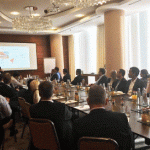On 11th May 2017 the Zurich FP&A Board gathered 36 senior finance practitioners from such leading...
 Does your finance department add true value to the business? Do you see finance influence decision making in your organisation? Is finance always invited to attend strategic business meetings? Is finance in your organisation perceived as a true business partner by the other functions and key stakeholders?
Does your finance department add true value to the business? Do you see finance influence decision making in your organisation? Is finance always invited to attend strategic business meetings? Is finance in your organisation perceived as a true business partner by the other functions and key stakeholders?
If the answer to any of the above questions is “no”, it means a transformation from controlling to finance business partnering function is needed.
In this article, I would like to share with you my experience when I took over the responsibility of leading the finance department in a multinational FMCG company.
The finance department at that time was strong in controlling, the team was providing accurate financial statements, all controls were in place, working capital was managed well, etc.
So, from the controlling perspective the finance function was doing a very good job.
However, when I spoke to business stakeholders, I discovered a big gap in the finance function in terms of giving proper support to the business. There was a minimal finance involvement in decision making, the commercial team was not getting value-added insights from finance. Also, there was a weak relationship between finance and the other functions, and finance had no seat in most of the strategic meetings.
At that time, I realised that I had to make a major transformation in the finance function from being only a controlling function to becoming a true finance business partner who should add value to the business.
The 5-Step Transformation Journey:
1. Build a relationship with the business partners/stakeholders and understand their needs.
I started conducting one-on-one meetings with key stakeholders (General Manager, Sales directors, key account managers, marketing, supply chain, and HR). I listened carefully to their expectations from finance and what their needs were. I asked them to share examples from history. After deep discussions with them, I began to think of quick wins to start building credibility with them. Then I set short-term and long-term goals on how to add true value to the business and gain their trust.
2. Understand the business and the organisation.
The second step was to understand the business model, the value chain, the company’s strategy, who are the competitors, what are our products’ benefits vs competitors, who are our distributors and wholesalers, who are the key customers, etc.
To reach the needed level of business acumen, I had to do a lot of things together with my team – attend all possible business meetings, speak to business at all level (sales directors, managers, sales reps, product managers, supply chain, HR, etc.) in a form of formal arranged meeting or even casual at the coffee machine.
We had to make frequent field visits with the commercial team and see the day to day challenges of the sales team on the ground. We spoke to consumers, saw our products position in the point of sales areas, …etc.
We had to take notes of all of our observations, recording all the feedback, and we had to prepare a field visit report after every single visit and discuss it with the commercial leaders to get their feedback.
The outcomes from the frequent field visits were fantastic, myself and my team got deep business understanding and we were able to understand clearly what was behind the reported numbers. It also helped in building strong business relationships with commercial people.
3. Improve reporting & performance management tools
The third step I had to implement was developing proper reporting tools that really add value to the business and align with the commercial and business leaders’ expectations. It was powerful because we built it after deep business understanding.
So, as a finance business partner, we planned the following:
- Create an interactive smart solution to provide strong support to the commercial team and business decision-makers to make quick, effective and fact-based decisions;
- Give commercial teams more free time to focus on in-market activities;
- Highlight critical opportunities /gaps in the market;
- Develop a user-friendly and interactive tool that can be accessed at any point in time;
- Help the commercial team to prepare accurate forecast using monthly and annual trends;
- Have one accurate source of financial/commercial information replacing all previous reports.
The results were outstanding. The commercial team was very happy with the new smart tool, it replaced all of the existing reports with one accurate source of information, it saved time for many functions – Sales, Marketing, Finance & Leadership Team.
- The commercial team was able to focus on in-market activities rather than on time-consuming tasks in seeking and analysing information.
- Quick and accurate decisions were taken.
- Full control of key account business and top customers performance was implemented on a daily/monthly basis.
- Leadership meetings became more productive due to focusing on key business gaps using smart dashboard reports.
4. Provide insights and influence decision making
The great combination of understanding the business and having the right reporting tools, and having a good relationship with other stakeholders helped us a lot in providing powerful insights to business by adding to our reports the proper business questions, the right business story and message, the appropriate and realistic actionable insights and action plans.
At that time, Finance started to support decision making big time and added true value to the business.
5. Gain the trust of business stakeholders
After implementing the above transformation steps, the finance function got a permanent seat in all business decision making meetings, it became an essential part of the S&OP meeting, sales and marketing meeting, annual key account contracts renewal meetings, and other key operational and strategic meetings.
Finance learned to speak with business their language, not the technical finance language. The finance team was involved in the day to day business activities working very closely with business people, and overtime finance succeeded in gaining the trust of all stakeholders who realised the true value of finance input.
At the end of the transformation journey, the finance team was able to influence decision making and became a true business partner.
Subscribe to
FP&A Trends Digest

We will regularly update you on the latest trends and developments in FP&A. Take the opportunity to have articles written by finance thought leaders delivered directly to your inbox; watch compelling webinars; connect with like-minded professionals; and become a part of our global community.






